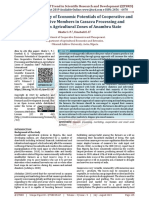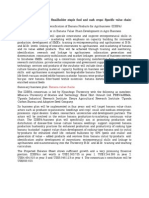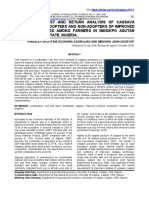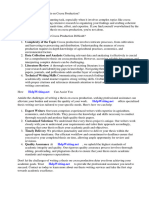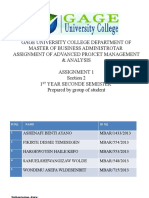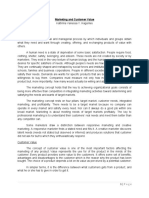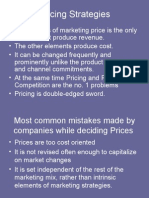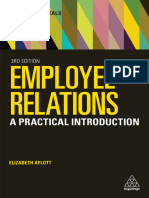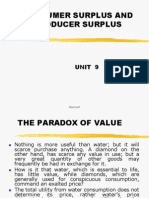Professional Documents
Culture Documents
Banana Fruits Enterprises Profitability Analysis in Odigbo Local Government Area, Ondo State, Nigeria
Copyright
Available Formats
Share this document
Did you find this document useful?
Is this content inappropriate?
Report this DocumentCopyright:
Available Formats
Banana Fruits Enterprises Profitability Analysis in Odigbo Local Government Area, Ondo State, Nigeria
Copyright:
Available Formats
Volume 7, Issue 3, March – 2022 International Journal of Innovative Science and Research Technology
ISSN No:-2456-2165
Banana Fruits Enterprises Profitability Analysis in
Odigbo Local Government Area, Ondo State, Nigeria
Ajibade, Y.E., Ameh, O.E., Onoja, N.M. and Jeremiah D. J.
Department of Agricultural Economics and Extension,
Faculty of Agriculture, Kogi State University, Anyigba, Nigeria
Abstract:- The broad objective of this study is to analyze I. INTRODUCTION
banana fruits enterprises profitability in Odigbo Local
Government, Ondo State, Nigeria. The study specifically Banana (Musa. Spp) is one of the major commodities
described the socio-economic characteristics of the in agricultural sector which is used as both food and cash
respondents, estimated costs and returns of actors, crop. Banana fruits are among the world’s most popular
determined the respondents profitability and identified fruits and it varies in color, size and shape. Most banana are
constraints faced by various actors. A multi-stage Musa acuminate (cooking banana or plantain), Musa
sampling technique was used for this study. A well- paradisiacal (banana or french plantain) and Musa
structured questionnaire coupled with personal balbisiana (wild banana). The most common type of desert
interview was used to elicit information from one banana is Cavendish. It’s green when unripe and turns
hundred and twenty respondents. The results showed yellow as it matures.It contains a fair amount of fiber as
that majority (52.2%) of the respondents were male. well as several antioxidants. Each banana fruit contains
Majority of the respondents belonged to the age bracket about hundred and five (105) calories and exclusively
of 60-69years. Majority (70.0%) of the respondents were contain water and carbs. The protein content is little with no
married with a household size of 1-10 persons. Majority fat. The carbs in green, unripe banana fruit consists mostly
(53.33%) had formal education with majority (40.83%) of starch and resistant starch but as banana fruit ripens, the
having experience of 11-20 years’ in banana venture. starch turns into sugar (glucose, fructose and sucrose).
The results showed that producers incurred a total cost
of N259,036.67k per annum, earned a total revenue of India is the largest banana fruit producing country in
N2,160,422.22k per annum.. The producers earned the world with a total production of 39million metric tons
gross margin of N1,907,826.89k per annum with 8.34 as which represents 18percent of the world’s total production
return on investment. The results also showed that (FAO, 2012). Uganda is the largest producer of banana fruit
processors incurred total cost of N158,343.63k per in the Sub-Saharan Africa (SSA) followed by Rwanda,
annum, with a total revenue of N2,232,260.50k per Ghana, Nigeria and Cameroon (FAOSTAT, 2018). Banana
annum. The results showed e gross margin of fruit is a major staple food in Tanzania and Uganda, it is
N2,074,986.72k per annum with 14.10 as return on also an important cash crop in their local economy (IITA,
investment.The results showed that 2014). Nigeria is among the largest banana fruit producing
producers/processors incurred a total cost of countries in Africa Producing about 2.8million metric tons
of banana annually, with a production area which covers
N1,095,172.86k per annum and earned total return of
N9,237,910.00k per annum from banana production and about 450,000 hectares of land. It is widely produced in
processing. Their gross margin was N9,237,910.00k per south and central regions of the country such as; Oyo, Edo,
annum with 9.42 return on investment. The results Ondo, Bayelsa, Delta, Akwa Ibom, Rivers, Ogun, Cross
showed that marketers incurred a total cost of river, Ebonyi, Abia, Ekiti, Imo, Plateau, Osun, Kogi,
N132,727.45k per annum and earned a total revenue of Anambra and Enugu States. Banana fruits have always been
N204,700.00k per annum from banana marketing. The important traditional staples for both rural and urban
results showd that actors faced diverse constraint in populaces in Nigeria. Banana fruit distribution in Nigeria is
their various ventures. Therefore, their should be a bit complex, farmers whose land lies near major roads,
construction of good road networking for effective harvest the crop at the mature green stage and display it at
transportation of banana produce and products to the the roadside or transport the crop to nearby markets,
ultimate consumers. allowing small scale wholesalers, retailers and consumers to
purchase directly. In some cases assemblers move around
Keywords:- Banana, Profitability, Enterprises, Fruits, farms, collect the produce from farmers and transport it to
Odigbo Local Government Area. cities where they hand them over to wholesalers who in turn
pass the produce on to the retailers or vendors for sale to the
ultimate consumers (EPAR, 2013).
According to Aliyu ( 2012), the value chain network
may be defined as a range of activities that are required to
bring a product from its conception, through its designing,
sourcing raw materials and intermediate inputs, marketing
and distribution to the final consumers. Harbir (2011) stated
that, producers gain from increased knowledge, better
quality and food safety, reduced costs end losses, higher
IJISRT22MAR955 www.ijisrt.com 1530
Volume 7, Issue 3, March – 2022 International Journal of Innovative Science and Research Technology
ISSN No:-2456-2165
sales and greater value addition in production through Value chain theory is a business model that describes
modern integrated value chains.The traditional way of food the full range of activities needed to create a product or
production is being replaced by practices more similar to service. For companies that produce goods, a value chain
manufacturing processes, with greater coordination across comprises the steps that involve bringing a product from
farmers, processors, retailers and other stake holders in the conception to distribution, and everything in between such
value chain. Anjani (2012), stated that civilization has as procuring raw materials, manufacturing functions, and
changed the pattern of food consumption with demands for marketing activities. A company conducts a value-chain
high value commodities in terms of quality and safety such analysis by evaluating the detailed procedures involved in
as frozen, pre-cut, pre-cooked and ready to eat foods has led each step of its business. The purpose of a value-chain
to concern for a more sophisticated production, processing analysis is to increase production efficiency so that a
and distribution systems which is known as value chain. company can deliver maximum value for the least possible
cost. A value chain is a step-by-step business model for
Banana fruit production has potentially contributed to transforming a product or service from idea to reality. Value
the economy over the years, in terms of employment chains help increase a business's efficiency so the business
creation, nutrient improvement, extra income generation and can deliver the most value for the least possible cost. The
reduces poverty in rural areas (Kamal et al., 2014). Banana end goal of a value chain is to create a competitive
fruit can be transformed from its initial form to a finished advantage for a company by increasing productivity while
product through processing, enhancing different food keeping costs reasonable.
varieties in terms of taste and human want e.g., banana fruit
juice, banana chips etc. Banana fruit enterprise has several The value-chain theory analyzes a firm's five primary
constraints that hinder further expansion and good activities and four support activities. Because of ever-
performance among the key actors. The poor performance of increasing competition for unbeatable prices, exceptional
farmers arose due to the low prices paid for their produce. products, and customer loyalty, companies must continually
The consequence of low price is due to poor processing, examine the value they create in order to retain
branding, packaging and storage which lead to relatively their competitive advantage. A value chain can help a
low quantities of banana fruit and post-harvest losses. The company to discern areas of its business that are inefficient,
low prices paid for banana lead to low farmer’s income, then implement strategies that will optimize its procedures
discouraging banana fruit farming among the poor rural for maximum efficiency and profitability.In addition to
livelihood. The other group is traders including wholesalers ensuring that production mechanics are seamless and
and retailers who always tend to maximize profits. efficient, it's critical that businesses keep customers feeling
According to Nkuba (2003), many producers have no confident and secure enough to remain loyal. Activities
information about prevailing prices in the markets. Hence, overarching goal of a value chain is to deliver the most
educating farmers on good banana production practices right value for the least cost in order to create a competitive
from the field to storage is an integral part of value chain advantage.
development and will help to alleviate low profit. Also the
role of the various actors in the banana fruit value chain is Although, various studies have been carried out on
unknown due to an invisible supply chain that exist among Musa Spp such as analysis of operational efficiency of
them in the distribution of banana fruit. There is a global cooking banana (also known as plantain) marketing in
need for value addition to agricultural produce such as Odigbo Local Government Area, Ondo State (Aina et al.,
banana fruit which at recent year received better attention 2012). Adeoye et al. (2013), also studied cooking banana
for its comparative advantage and better adaptability to the fruit (plantain) value chain mapping in the southwestern part
study area. Value chain theory is a business model that of Nigeria The zone is made up of six states namely Lagos,
describes the full range of activities needed to create a Oyo, Ogun, Osun, Ekiti and Ondo States. Akinyemi et al.
product or service. For companies that produce goods, a (2017) also studies the market structure and performance of
value chain comprises of the steps that involve bringing a banana and cooking banana in Oyo state Nigeria.This study
product from conception to distribution, and everything in is specifically interested in knowing the activities of four
between such as procuring raw materials, manufacturing major banana actors in banana market chain in Odigbo
functions, and marketing activities. A company conducts Local Government Area. Also, Thus, the study considered
a value-chain analysis by evaluating the detailed procedures banana producers (farmers), banana processors, banana
involved in each step of its business. The purpose of a producers/processors and banana fruits and fruit products
value-chain analysis is to increase production efficiency so marketers. To the best of the author’s knowledge, there were
that a company can deliver maximum value for the least little or no efforts on the need to visualize network and key
possible cost. A value chain is a step-by-step business model actors in the banana fruit Value Chain in the study area.This
for transforming a product or service from idea to reality. is the gap this study is filling; it aims at examining banana
Value chains help increase a business's efficiency so the fruits enterprises in Odigbo Local Government Area, Ondo
business can deliver the most value for the least possible State, Nigeria. The study answered the following research
cost. The end goal of a value chain is to create a competitive questions:
advantage for a company by increasing productivity while What are the socio-economic characteristics of actors in
keeping costs reasonable. banana fruit in the study area?
What are the costs and returns of various banana fruit
enterprises in the study area?
IJISRT22MAR955 www.ijisrt.com 1531
Volume 7, Issue 3, March – 2022 International Journal of Innovative Science and Research Technology
ISSN No:-2456-2165
What are the constraints faced by banana fruit enterprises III. MODEL SPECIFICATION
in the study area?
Gross Margin (GM) Analysis
II. METHODOLOGY This was used to estimate costs and returns of the actors in
banana enterprises in the study area.
The study was carried out in Odigbo Local
GM = TR – TVC
Government Area (LGA), Ondo State. The LGA is bounded Where: GM = Gross margin, TR = Total revenue, TVC =
by Latitudes 6°47′40″ N and Longitudes 4°52′3″ E, with Total variable cost.
about 1,818 km2. The LGA has a land mass of about 1,808 The net return represents the total profit and will be
square kilometers, density of about 173.5 kilometer square
determined using:
and has about 150 towns and villages with population of
Net return = TR – TC,
about 313,600 according to National Population Where:
Commission of Nigeria (NPCSN) and National Bureau of TR = Total revenue
(NBS Statistics) 2016. The Local Government is made up of
TC = Total cost
of Ore, Oniparaga, Odigbo, koseru, Ebijan, Ayesan, Rate of return to investment (ROR) =
Araromiobu, Ajue, Ago-Alaye and Agbagu. It is a lowland 𝒄𝒖𝒓𝒓𝒆𝒏𝒕 𝒗𝒂𝒍𝒖𝒆−𝒊𝒏𝒊𝒕𝒊𝒂𝒍 𝒗𝒂𝒍𝒖𝒆
within a humid forest zone with a mean cumulative annual ˟ 100
𝒊𝒏𝒊𝒕𝒊𝒂𝒍 𝒗𝒂𝒍𝒖𝒆
rainfall of 1,320 mm. It has monthly mean temperatures that
vary from 27.6°C to 31.6 °C. The wet season lasts about IV. RESULTS AND DISCUSSION
seven to eight months, while the dry season lasts three to
A. Socio-economic Characteristics of the Actors
four months. The Local Government Area falls within the
The results in Tables1 describes the socio-economic
rain forest region with abundant rainfall and sunshine, thus
characteristics of the respondents (banana producers, banana
favouring agricultural practice. Many people in this area
processors, banana producers/processors and banana
engage in farming as their sole occupation, the major crops
marketers). Majority of the respondents (52.5%) were male,
cultivated are cocoa, kolanut, oil palm, coffee, rubber,
while 47.5% were female. The predominance of male in
cassava, pepper, plantain and banana. The people also
banana enterprise could be attributed to heavy involvement
engage in other occupations such as trading, teaching,
of men in cocoa production in the area and they usually
tailoring, hunting, and craft making, especially in the area
plant banana as shade tree for cocoa at tender age and
headquarters and major towns.
because of tedious activities involved in land preparation
Many parts of Odigbo Local Government are inhabited and other value addition processing of banana. This concurs
by non-indigenes like people from Oyo and Osun States and with the findings of Ayanwale et al. (2018) who revealed
some parts are occupied by the Ikale people of Okitipupa that 92.0% of the respondents were male. The mean age of
and Irele Local Government Area, Ondo State. The major respondents was 56.1, years, However, majority of the
language spoken in the LGA is Yoruba.. The soil types respondents (75.67%) fell within 40-69 years. working age.
comprises of DystricNitosols (Nd) 57.42%, Ferric Luvisols This implies that people of younger age do not consider
(Lf) 22.26%, EutricNitosols (Ne) 11.87%, Gleysols (G) banana enterprise as serious occupation, since banana is
7.64%, and Dystric, Regosols (Rd) occupy 0.81% of the originally being planted as a shade crop for cocoa and other
study area (FAO-UNSECO , 2007). permanent crops. This opposes the study carried out by
Ayanwale et al. (2018) who reported that majority (60.0%)
A multi-stage sampling technique was used for this of the respondents fall within the age brackets of 41-60
study. The first stage was a random sampling of Odigbo years, while 30.71% falls within 20-40years and 9.29% were
Local Government Area among the eighteen(18) LGAs in 60years and above. Majority (70.0%) of the respondents
Ondo State. In the second stage, purposive selection of four were married while others were single, widowed and
(4) villages, which include, Ore, Odigbo, Omifon and divorced. This implies that the respondents were
Asewele where banana fruit enterprises are concentrated . In responsible men and women. The findings concurs with the
the third stage, random selection of thirty (30) respondents submission of Akinbile (2007) who posited that marriage
from banana fruit enterprises each ( banana fruits producers, confers responsibility. The findings showed that most of the
banana fruit processors, banana fruit producers/processors respondents had household size of 1- 10 persons, thus,
and banana fruit product marketers) across the four (4) majority of them could access family labour to increase their
villages making a total sample size of one hundred and production and reduce cost of production and processing
twenty (120) respondents. respectively. The result is in line with the findings of
Banmeke et al. (2008) who stated that large household size
A well-structured questionnaire coupled with personal serve as an important source of labor. The results showed
interview was used in eliciting information from the that majority (40.83%) of the respondents had spent an
respondents. Primary data were collected for this study. The upward of ten years in their respective enterprises. This
data collected were analyzed using descriptive and results concur with the findings of Akinyemi et al (2017)
inferential statistics. Objective (i and iii) were analyzed who revealed that respondents had an average of 20 years of
using descriptive statistics which consist of frequencies, experience which showed that respondents had spent long
percentages, tables and mean, while Objective (ii) was years in banana enterprise and could predict possible
analyzed using gross margin and profitability ratio. problems and likely solutions that may result in higher
profits with regards to the business (Ben- chedo et al.,
IJISRT22MAR955 www.ijisrt.com 1532
Volume 7, Issue 3, March – 2022 International Journal of Innovative Science and Research Technology
ISSN No:-2456-2165
2013). The results in Table1 also showed that majority having other sources of income because banana fruiting and
(75.00%) of the respondents were formally educated. Thus, harvesting is seasonal, it would be irrational for the actors to
their been literate could assist them in adopting new have banana enterprises as sole venture. Furthermore, the
innovation and skill in their various enterprises in terms of results showed that about 54.17% of the respondents
banana production, processing and marketing enterprises . belonged to cooperative society, while others belong to
The results is in tandem with the findings of Ariyo et al. other associations. Being a member of any organization
(2013), whose findings revealed that 87.0% of cooking could be an avenue for accessing information and other
banana actors had formal education. The results showed benefits to the enterprises . This findings concur to the
that these actors do not only produce, process and market findings of Asadu (2013), who reported that membership of
banana, over 50.0% also engaged in other income any organization is an added advantage which provide a
generating activities such as trading, craft and civil service. platform for interaction and contact among members..About
This implies that the respondents have other sources of 58.33% of the respondents do not have any special storage
income which could be invested into their banana facility, while others made use of sacks, basket and barns.
enterprises for expansion. However, there is need for
Variable Frequency Percentage Mode/Mean
Gender
Female 57.0 47.5 Male
Male 63.0 52.5
Total 120.0 100.0
Age
30-39 9.0 7.5
40-49 27.0 22.5
50-59 32.0 26.67
60-69 33.0 27.5 56.1(11.46)*
70-79 18.0 15.0
80-89 1.0 0.8
Total 120.0 100.0
Household
1-10 108.0 90.0 6.9(3.02)
11-20 12.0 10.0
Total 120.0 100.0
Experience
1-10 32.0 26.67
11-20 49.0 40.83 19.13(10.89)
21-30 21.0 17.50
31-40 12.0 10.0
41-50 6.0 5.0
Total 120.0 100.0
Martial status
Single 5.00 4.17
Married 84.0 70.0 Married
Divorced 10.0 8.33
Widow 21.0 17.5
Total 120.0 100.0
Level of Education
None 19.0 15.83
Primary 32.0 26.67
Secondary 58.0 48.33 Secondary
Tertiary 11.0 9.17
Total 120.0 100.0
Type of occupation
Craft 27.0 22.5
Hunting 21.0 17.5
Money lending 1.0 0.83
Tailoring 3.0 2.5 None
Teaching 2.0 1.67
Trading 10.0 8.33
None 56.0 46.67
Total 120.0 100.0
Association
IJISRT22MAR955 www.ijisrt.com 1533
Volume 7, Issue 3, March – 2022 International Journal of Innovative Science and Research Technology
ISSN No:-2456-2165
Cooperative 65.0 54.17 Cooperative
Farmers association 52.0 43.33
Others 3.0 2.5
Total 120.0 100.0
Types of storage
Ban 18.0 15.0
Basket 2.0 1.67
Sack/bag 30.0 25.0 None
None 70.0 58.33
Total 120.0 100.0
Table 1: Socio-Economic Characteristics of the Respondents
Source: Field Survey, 2020
Note: values in parentheses are standard deviation
B. Costs and Returns of Banana Producers of banana there was a return on investment of N8.34k. This
Table .2 showed that the banana producers incurred a concurs with the study of Ranathilaka et al. (2017) which
total cost of N259,036.67k per annum from banana fruits showed that the total cost from banana fruit production was
production and earned a total revenue of N2,160,422.22k N1,387,640.00K with the total revenue of N2,013,917.00k.
per annum. The result of the gross margin analysis shows The result of the gross margin was N1,242,772.00K. This
that production of banana is profitable with a gross margin implies that, banana fruit production is a highly profitable
of N1,907,826.89k per annum. The returns on investment is venture in the study area.
8.34. It implies that for every N1 investment in production
Cost items Aver. Qty Aver. Price Value
Variable cost
land clearing 30,333.33
Ridging 28,283.33
Suckers 1,967.67 25,543.33
Weeding 13,783.33
Fertilizer 131.29 8,250.00
Pesticide 1.83 6,806.67
Harvesting 13,510.00
Herbicide 42.03 1,360.00 57,165.33
Labour 26.30 2,500.00 65,750.00
Transport 3,170.00
Total Variable Cost 252,595.33
Fixed Cost(depreciation)
Matchet 1,249.00
Hoe 409.67
Digger 1,117.67
Wheel barrow 2,799.33
Sprayer 568.00
Sickle 297.67
Total fixed cost 6,441.33
Total cost 259,036.67
Returns 3,393.33 636.67 2,160,422.22
Gross Margin 1,907,826.89
Net farm income 1,901,385.56
ROR 8.34
Table 2: Costs and Returns of Producers
Source: Field Survey, 2020
IJISRT22MAR955 www.ijisrt.com 1534
Volume 7, Issue 3, March – 2022 International Journal of Innovative Science and Research Technology
ISSN No:-2456-2165
C. Costs and Returns of Processors in processing of banana fruits, there was a return on
The results in Table .3 shows that the respondents investment of N14.10k. This finding corroborates
incurred total cost of N158,343.63k per annum with a total Makindara et al. (2015) findings who showed that total cost
revenue of N2,232,260.50k per annum from banana fruits spent on banana fruits processing was N108,429,55.00k
processing. The result of the gross margin analysis shows with a total revenue of N216,000,000.00k with gross
that processing of banana fruit is profitable with a gross margin of N107,570,448k. Thus, banana processing is a
margin of N2,074,986.72k per annum, The return on profitable venture.
investment is 14.10. It implies that on every N1 investment
Cost items Aver. Qty Aver. Price Value
Variable cost
Cost of Banana processed 251.33 572.73 143,945.45
Peeling 2,393.33
Slicing 1,748.28
Drying 1,361.11
Grinding 2,078.95
Frying 2,250.00
Fermenting 1,600.00
Preservation 1,350.00
Transportation 546.67
Total Variable Cost 157,273.79
Fixed Costs
Peeler 214.21
Slicer 148.75
Dryer 220.00
Grinding Machine 136.88
Baking Machine 350.00
Total Fixed Cost 1,069.84
Total Cost 158,343.63
Returns
Flour 364.56 941.18 343,117.65
Juice 3,457.14 423.97 1,465,714.29
Chips 423,428.57
Total Returns 2,232,260.50
Gross Margin 2,074,986.72
Net returns 2,073,916.88
ROR 14.10
Table 3: Costs and Returns of Processors
Source: Field Survey, 2020
D. Costs and Returns of Producers/Processors N9,237,910.00K per annum. The return on investment is
The results in Table 4 showed that the respondents 9.42 which implies that for every N1 investment in
incurred a total cost of N1,095,172.86k per annum and production and processing of banana there was a return on
earned total return of N9,237,910.00k per annum from investment of N9.42k. This agrees with the findings of
banana fruits production and processing. The result of the Mbathu et et al. (2018) whose study showed that banana
gross margin analysis shows that production and processing fruit production and processing is profitable.
of banana is profitable with gross margin of
IJISRT22MAR955 www.ijisrt.com 1535
Volume 7, Issue 3, March – 2022 International Journal of Innovative Science and Research Technology
ISSN No:-2456-2165
Cost items Aver. Qty Aver. Price Value
Variable cost
A. Production
Land clearing 12,566.67
Ridging 7,600.00
Suckers 18,700.00
Weeding 7,566.67
Fertilizer 8,310.00
Pesticide 3,980.00
Harvesting 18,400.00
Herbicide 26.43 1,500.00 39,642.86
Labour 15.90 2,000.00 31,800.00
Total Production 148,566.20
B. Processing
Cost of banana fruits processing 1,553.33 572.73 889,636.36
Ripening 560.00
Peeling 4,426.67
Slicing 3,159.29
Drying 4,453.33
Grinding 5,236.36
Frying 5,916.67
Fermenting 3,233.33
Boiling 4,750.00
Baking 5,500.00
Preservation 3,533.33
Transportation 1,823.33
Total Processing 932,228.68
Total Variable Cost (A+B) 1,080,794.87
Fixed Cost(Depreciation)
C. Production
Matchet 735.33
Hoe 833.00
Digger 807.33
Wheel barrow 838.00
Sprayer 365.00
Sickle 386.00
Total fixed Cost(Production) 3,964.66
D. Fixed Cost (Processing)
Peeler 7,333.33
Slicer 1,020.00
Dryer 1,025.00
Grinding Machine 475.00
Baking Machine 550.00
Total Fixed Cost 10,403.33
Total Fixed Cost(C+D) 14,367.99
Total Cost 1,095,162.86
IJISRT22MAR955 www.ijisrt.com 1536
Volume 7, Issue 3, March – 2022 International Journal of Innovative Science and Research Technology
ISSN No:-2456-2165
Returns
Unprocessed Banana 1,268.18 572.73 739,772.73
Flour 2,112.08 911.24 1,924,625.00
Juice 17.57 1,667.89 29,307.14
Chips 1,837.50 3,125.85 5,743,750.00
Cookies 1,075.00 1,750.00 1,881,250.00
Total returns 10,318,704.87
Gross Margin 9,237,910.00
Net farm income 9,223,542.01
ROR 9.42
Table 4: Costs and Returns of Producer/Processors
Source: Field Survey, 2020.
E. Costs and Returns of Marketers investment in marketing of banana there was a return on
Table 5 showed the cost and returns of marketers, it investment of N1.54k This study correlates with the study
revealed that the respondents incurred a total cost of carried out by Akinyemi et al. (2017) which showed the
N132,727.45k per annum and earned a total revenue of return on investment to be 1.20 which implied that for every
N204,700.00k per annum from banana fruit products ₦1 invested, N 1.20k was realized as profit by banana
marketing. This indicates that the respondent earned a gross marketers, (₦1 = $0.006 at the time the study was carried
margin of N71,972.55k per annum. The return on out). This shows that banana marketing is a profitable
investment is 1.54. This implies that for every N1 enterprise.
Cost items Aver. Qty Aver. Price Value
Variable cost
Cost of banana 267.00 458.33 122,374.11
Transport 2,050.00
Storage 1,800.00
Taxes 670.00
Packaging 2,750.00
Advertising 1,616.67
Levies/Revenue 1,466.67
Total Variable Cost 132,727.45
Returns
Sales of Banana 267.00 766.67 204,700.00
Gross Margin 71,972.55
ROR 1.54
Table 5: Costs and Returns of Marketers
Source: Field Survey, 2020
F. Constraints Faced by Producers shortages or peaks of supply, with price fluctuation affecting
Table 6 showed that low technology (96.7%), pest and producers. He observed that during peak periods of
diseases infestation and vulagaries of weather (86.7%) were production, supply may outweigh demand, leaving little
the major constraints in the study area, while inadequate incentive for producers to market their produce in view of
input supply (26.7%) and inadequate labour supply (23.3%) low prices.
were not considered as constraints. This corroborates with
the findings of Zenebe et al. (2015) who considered banana
farming to be limited with access to reliable transport
networks and viable markets, poor handling and delays in
transport due to poor roads and deficient transportation
means, quality and poor price, inadequate infrastructure for
storing and marketing of bananas were considered as major
constraints in his study. Other constraints he stated were
limited flow of information from the markets to the farms
and vice versa increases the likelihood of unnecessary
IJISRT22MAR955 www.ijisrt.com 1537
Volume 7, Issue 3, March – 2022 International Journal of Innovative Science and Research Technology
ISSN No:-2456-2165
Constraints Frequency Percentage
1. Pest and diseases Infestation 26 86.7%
2. Low technology 29 96.7%
3. Vulgaries of weather 26 86.7%
4. Inadequate labour supply 7 23.3%
5. Inadequate inputs supply 8 26.7%
Table 6: Constraints Faced by Producers
Source: Field Survey, 2020.
G. Constraints Faced by Processors while low patronage (43.33%) was not considered as a
Table 7 showed that inadequate storage facilities constraint. This study concurs with the findings of Adeoye et
(70.0%), low market price (56.7%), huge transaction cost al. (2013), who found that the major constraints in cooking
(56.7%), inadequate storage facilities (53.33%), inadequate banana processing business were credit, training, labour,
capital (50.0%) were considered as the major constraints storage and transport. credit facilities.
Constraints Frequency Percentage
1.Low Market Price 17 56.7%
2. Huge Transaction Cost 17 56.7%
3. Inadequate Capital 15 50.0%
4. Low Patronage 13 43.33%
5. Inadequate processing facilities 21 70.0%
6. Inadequate Storage facilities 16 53.33%
Table 7: Constraints Faced by Processors
Source: Field Survey 2020
H. Constraints faced by Producers/Processors inadequate capital (26.7%), low patronage (23.33%) and
Table 8 showed that huge transaction cost (76.0%), high costs of farm and processing inputs (23.33%) were not
inadequate farm machinery and processing facilities considered as constraints. This study correlate with the
(76.7%), vulgaries of weather (70.0%), pests and disease finding of Mbathu et al. (2018), who considered poor
infestation (63.3%) were considered as the major pricing, distance to market, low technical know-how,and
constraints, while inadequate storage facilities (46.7%), poor transport as the major constraints in his study area.
pricing (30.0%), inadequate labour supply (30.0%),
Constraints Frequency Percentage
Poor Pricing 9 30.0%
Huge transaction cost 23 76.7%
Inadequate of capital 8 26.7%
Low Patronage 7 23.33%
Inadequate farm machineries and processing facilities 23 76.7%
Inadequate Storage facilities 14 46.7%
High costs of processing and farm Input 7 23.3%
Inadequate Labour supply 9 30.0%
Pest and Diseases infestation 19 63.3%
Vulgaries of weather 21 70.0%
Table 8: Constraints Faced by Producers/Processors
Source: Field Survey, 2020.
IJISRT22MAR955 www.ijisrt.com 1538
Volume 7, Issue 3, March – 2022 International Journal of Innovative Science and Research Technology
ISSN No:-2456-2165
I. Constraints Faced by Marketers (30.0%), low patronage (26.7%), high transaction cost
Table 9 showed the extent to which different constraints (26.7%) and poor market information (16.7%) were not
hinders the banana fruits and product marketing in the study major constraints. This concurs with the study of (Amen et
area. The Table showed that poor pricing (83.3%), poor road al., 2018) who found that market distance was not
networking (83.3%) were considered as major constraints in satisfactory and it is comparatively far away which in turn
banana fruits and product marketing. Inadequate capital has led to high transport cost.
Constraints Frequency Percentage
1. Poor pricing 25 83.3%
2. Low patronage 8 26.7%
3.High transaction cost 8 26.7%
4. Inadequate capital 9 30.0%
5.Poor market information 5 16.7%
6.Poor road networking 25 83.3%
Table 9: Constraints Faced by Marketers
Source: Field Survey, 2020
V. CONCLUSION AND RECOMMENDATION [5.] Amen, D.D., &Desalegn D. (2018). Analysis of
Socio-Economic Factors Affecting Banana
This study examined banana fruits enterprises in Production: Evidences From Lowlands of
Odigbo Local Government Area, Ondo State, Nigeria. The Ubadebreschayworeda, GamoGofazone SNNPIS:
study identified four different banana fruit enterprises in the Journal of Economic and Sustainable Development.
study area (banana fruit producers, producer/processors and ISSN 2222-17000 (Paper) ISSN 222.2855 (Online)
marketers). Majority of the respondents were men and Vol. 9. Nov9
were majorly old people, with many years of experience in [6.] Anjani, K. (2012). Value Chain of Agricultural
their respective enterprises. Both male and female Commodities and their Role in Food Security and
respondents were married and responsible. All the Poverty Alleviation. Agricultural Economics
enterprises were profitable and viable. However, each of the Research. Review. January–April, 2012. Pp. 149–
enterprises had varied constraints ranging from huge cost of 152
transaction, inadequate capital, transportation, inadequate [7.] Ariyo, O.C, Ariyo, M.O, Okelola O.E, Omodona, S,
storage and processing facilities among others, Thus, Akesode, H.A, &Akanni R.J (2013). Profitability
younger people should be encourage to engage in banana Analysis of Cooking Banana Marketing in Kaduna
fruit enterprises. They should come together to generate Metropolis, Kaduna State Nigeria. Journal of
more capital to purchase storage and processing facilities for Agricultural and Social Research.
increase production and prevent wastage and ridiculous [8.] Ayanwale .B.A, Abiodun .F.O &Paul .O.M (2018),
pricing at the peak of harvest. Baseline Analysis of Plantain (Musa Sp.) Value
Chain in Southwest of Nigeria. FARA Research
REFERENCES Report. Vol. 3(1): PP 84.
[9.] Banmeke, T.O.A &Ajayi O.T. (2008): Accessibility
[1.] Adeoye I. B., Omobowale A. O., Sulaiman A. Yusuf of Women Farmers to Agricultural Information in
&Kemisola O. A. (2013). Plantain Value Chain South Western Nigeria. South African Journal of
Mapping in South-western Nigeria, National Agricultural Extension, 34 (2): 237-246.
Horticultural Research Institute, P.M.B 5432, Idi- [10.] Ben-Chedo, G.N, Ezel, C.C &Asiabaka, C.C (2013).
Ishin, Department of Agricultural Economics, Value Addition to Cooking Banana by Women
University of Ibadan, Ibadan, Nigeria Journal Of Entrepreneurs in Imo State, Nigeria. Dev. Country
Economics And Sustainable Development. Vol. 4, Studies 3 (10): 130-138.
No.16. Www.Iiste.OrgISSN 2222-1700 (Paper) ISSN [11.] EPAR, (2013). Evans School Policy Analysis and
2222-2855 (Online). Research, Banana and Plantain Value chain: West
[2.] Akinbile, L.A, (2007). Standardization of Socio- Africa EPAR Brief No. 239.
Economic Status (SES) Scale for Farm Families in [12.] FAO, (2012). Food & Agricultural Organization of
South Western Nigeria: Journal of Social Sciences. the United Nations. Http://Www.Fao.Org.Valuechain
14 (3), 221-227. [13.] FAOSTAT, (2018). Food & Agricultural
[3.] Akinyemi, S. O. S, Adejoro, M. A., Layade, A. A. Organization Statistics. Http://Faostat.Fao.Org
&AdegbiteO. O. (2017). Market structure and [14.] FAO-UNESCO (2007). Digital Soil Map of the
Performance for Plantain and Banana. International World.
Journal of Fruit Science, Vol. 17:4, Pp. 440-450, [15.] Harbir, S. K. (2011). Modern Integrated Value Chain
DOI: 10.1080/15538362.2017.1360231 Actors. Research Journal of Agricultural
[4.] Aliyu, O. M. (2012). Annual Research Report of the Economics.Pp 169 – 180
Cocoa Research Institute of Nigeria Ibadan, Nigeria.
Pp. 30 – 31
IJISRT22MAR955 www.ijisrt.com 1539
Volume 7, Issue 3, March – 2022 International Journal of Innovative Science and Research Technology
ISSN No:-2456-2165
[16.] IITA (2014). International Institute of Tropical
Agriculture in Banana and Plantain.
.Http://Www.Iita.Org/Bananaand-Plaintain
[17.] Kamall, M.S, Ali, M.A &Alam, M.A (2014). Socio-
Economic Status and Problem of Banana Growers in
Bangladesh. International Journal of National and
Social Sciences. 1 (2): 91-99
[18.] Makindara, J., Alex, A. Tmueweigye&Sikiraa.
(2015). Opportunity For Parading The Banana Value
Chain In Uganda , Forum For Agricultural Research
In Africa (FARA), Accra, Ghana, Sokoine University
of Agriculture, Morogoro. Journal of Continuous
Education and Extension. JCEE, Tanzania, Vol. 6
Issue1. Corresponding Authors:
Aariho@Faraafrica.Org
[19.] Mbuthia, S.W, Calvine, K. &Stephen K.W (2018)
Constraints to Profitable Participation Agri-Food
Value Chains, Department Of Geography, Kenyatta
University, Kenya. International Journal of Scientific
Research. Publication, Issue 7 July, 2018. ISSN
2250-3153, Vol. 8 29322/IJ SRP. 8.7, 2018. P7912,
D10:10.
[20.] National Population Census (NPC) (2006). National
Bureau of Statistics Official Gazette (FGP 71/5-
2007/2 500(O.L) Abuja URL
.Http//www.Nigeriasta.Gov.Ng.
[21.] Ranathilaka, M.B, Neluma, L, &Wasantha A. (2017).
A Cost Benefit Analysis On Production And
Marketing of Banana. Journal of Smart Economic
Growth. 3 (3), 69-83.
[22.] Zenebe, W., Mohammed A., Derebew, B., Zakarias,
S., & Adams, B (2015). Accessement of Banana
Production and Marketing in Ethiopia: International
Journal of Sciences, Basic and Applied Research
(IJBARI). Vol. 24, NI3, PP, 283-307.
IJISRT22MAR955 www.ijisrt.com 1540
You might also like
- 1 PBDocument10 pages1 PBSemogga BissaNo ratings yet
- Marketing Analysis of Vegetables: The Case of Carrot and Cucumber Marketing in Enugu State, NigeriaDocument7 pagesMarketing Analysis of Vegetables: The Case of Carrot and Cucumber Marketing in Enugu State, Nigerias sireeshaNo ratings yet
- 2013JE AnietalDocument8 pages2013JE AnietalEDWARDNo ratings yet
- Grapes IndiaDocument4 pagesGrapes IndiaMrunali GaikwadNo ratings yet
- Comparative Study of Economic Potentials of Cooperative and Non Cooperative Members in Cassava Processing and Marketing in Agricultural Zones of Anambra StateDocument8 pagesComparative Study of Economic Potentials of Cooperative and Non Cooperative Members in Cassava Processing and Marketing in Agricultural Zones of Anambra StateEditor IJTSRDNo ratings yet
- Asmiro 2022ArticleBananavaluechainsustainabilityDocument11 pagesAsmiro 2022ArticleBananavaluechainsustainabilityKev NionNo ratings yet
- JEMAD Vol 7 No 2 Maghirang 1Document12 pagesJEMAD Vol 7 No 2 Maghirang 1FrancisNo ratings yet
- Economic Analysis of Cassava Production: Prospects and Challenges in Irepodun Local Government Area, Kwara State, NigeriaDocument5 pagesEconomic Analysis of Cassava Production: Prospects and Challenges in Irepodun Local Government Area, Kwara State, Nigerianicholas ajodoNo ratings yet
- AibonoDocument21 pagesAibonoAishwarya Hassa PurtyNo ratings yet
- Analysis of Maize Value Addition Among Entrepreneurs in Taraba State, NigeriaDocument9 pagesAnalysis of Maize Value Addition Among Entrepreneurs in Taraba State, NigeriaIJEAB JournalNo ratings yet
- Banana VCin Ethiopia AsmiroDocument11 pagesBanana VCin Ethiopia AsmirovipinNo ratings yet
- Assessment of Profit Efficiency Among Sweet Yellow Passion Fruit Farmers in Mbeere South Embu County, KenyaDocument10 pagesAssessment of Profit Efficiency Among Sweet Yellow Passion Fruit Farmers in Mbeere South Embu County, KenyaAmos ChachaNo ratings yet
- Oil Palm Processing in NigeriaDocument14 pagesOil Palm Processing in NigeriaEDWARD100% (1)
- 29-Article Text-75-2-10-20200813Document12 pages29-Article Text-75-2-10-20200813Oyeleye TofunmiNo ratings yet
- Factors Affecting Sago Marketing Efficiency in Southeast SulawesiDocument4 pagesFactors Affecting Sago Marketing Efficiency in Southeast SulawesiTiara RamadhanNo ratings yet
- A Value Chain Analysis of the Cassava Sub-sector in UgandaDocument64 pagesA Value Chain Analysis of the Cassava Sub-sector in UgandaMaureen TNo ratings yet
- EJBMR - Aditia AbdurachmanDocument4 pagesEJBMR - Aditia AbdurachmanAditia AbdurachmanNo ratings yet
- Trade PerformanceDocument17 pagesTrade Performancebizuayehu admasuNo ratings yet
- Preliminary Examination of The Processes of Production and Value Chain Management of Indigenous Shea Butter Marketed in NigeriaDocument9 pagesPreliminary Examination of The Processes of Production and Value Chain Management of Indigenous Shea Butter Marketed in NigeriaEditor IJTSRDNo ratings yet
- 1 s2.0 S0306919223000957 MainDocument20 pages1 s2.0 S0306919223000957 MainzainurihanifNo ratings yet
- Banana Fiber Business PlanDocument2 pagesBanana Fiber Business Planfamtooz33% (3)
- Profitability Analysis of Coffee Production Among Adopters and Non-Adopters of Improved Coffee Varieties in Mbinga and Mbozi DistrictsDocument18 pagesProfitability Analysis of Coffee Production Among Adopters and Non-Adopters of Improved Coffee Varieties in Mbinga and Mbozi DistrictsInternational Journal of Innovative Science and Research TechnologyNo ratings yet
- IITA Bulletin 2252Document4 pagesIITA Bulletin 2252International Institute of Tropical AgricultureNo ratings yet
- 1597165857AFE 202 ASSIGNMENT Aransiola Grace Oluwadunsin Business PlanDocument16 pages1597165857AFE 202 ASSIGNMENT Aransiola Grace Oluwadunsin Business PlanMBI TABENo ratings yet
- BusStratDev 2021 Sedky StudyinggreenmarketinginemergingeconomiesDocument11 pagesBusStratDev 2021 Sedky Studyinggreenmarketinginemergingeconomiespgdm23muditjNo ratings yet
- 179848-Article Text-459072-1-10-20181119Document9 pages179848-Article Text-459072-1-10-20181119Oyebola Akin-DeluNo ratings yet
- Bourquin PFID Mango Market Development ProjectDocument30 pagesBourquin PFID Mango Market Development Projectgyansoft2009No ratings yet
- Support For Small Rice Threshers in Nigeria.: August 2007Document63 pagesSupport For Small Rice Threshers in Nigeria.: August 2007MUSTAPHA SHEHU ABUBAKARNo ratings yet
- Tablas y PárrafosDocument5 pagesTablas y PárrafoscarlosisazaNo ratings yet
- Impact of Fecal Waste Management On The Profitability of Poultry Farmers in NigeriaDocument12 pagesImpact of Fecal Waste Management On The Profitability of Poultry Farmers in NigeriaMamta AgarwalNo ratings yet
- ProblemsDocument13 pagesProblemsMyirele FondaNo ratings yet
- Innovative Futuristic Approach For Sustainable Sugar IndustryDocument6 pagesInnovative Futuristic Approach For Sustainable Sugar IndustryAnonymous lAfk9gNPNo ratings yet
- 583 1924 1 PBDocument28 pages583 1924 1 PBShawn MenNo ratings yet
- Welfare and Productivity Impact of Adoption of Biofortified Cassava by Smallholder Farmers in NigeriaDocument21 pagesWelfare and Productivity Impact of Adoption of Biofortified Cassava by Smallholder Farmers in NigeriaDinka'a Adrian YebitNo ratings yet
- Thesis On Cocoa ProductionDocument7 pagesThesis On Cocoa Productionafbtmznam100% (2)
- 14 Fr-Kliafp-003 MD SuhaimiDocument12 pages14 Fr-Kliafp-003 MD SuhaiminfkryhNo ratings yet
- Advanced Projcet Management PresentationDocument52 pagesAdvanced Projcet Management Presentationsemetegna she zemen 8ተኛው ሺ zemen ዘመንNo ratings yet
- Nadja 2019 IOP Conf. Ser. Earth Environ. Sci. 343 012107Document9 pagesNadja 2019 IOP Conf. Ser. Earth Environ. Sci. 343 012107Nam LêNo ratings yet
- Potential of Fruit Plants in The Yard To Support Urban Farming and Agroindustry in Madiun-City, East Java, IndonesiaDocument7 pagesPotential of Fruit Plants in The Yard To Support Urban Farming and Agroindustry in Madiun-City, East Java, IndonesiaIJAERS JOURNALNo ratings yet
- Cocoa FarmingDocument141 pagesCocoa FarmingBesong MichaelNo ratings yet
- 6 Field Vegetable ProductionDocument2 pages6 Field Vegetable ProductionFursey WhyteNo ratings yet
- Productivity Value Chain Analysis of Cassava in THDocument9 pagesProductivity Value Chain Analysis of Cassava in THMartine Debbie CorreNo ratings yet
- ojbm_2023112714570440Document18 pagesojbm_2023112714570440mohamed adamNo ratings yet
- Report of The PLAN Nigeria Symposium at 3AAHC 2016 - Final AO Sept 14 2016 PDFDocument34 pagesReport of The PLAN Nigeria Symposium at 3AAHC 2016 - Final AO Sept 14 2016 PDFAugustine OkoruwaNo ratings yet
- Rosiana - 2022 - IOP - Conf. - Ser. - Earth - Environ. - Sci. - 1107 - 012083Document12 pagesRosiana - 2022 - IOP - Conf. - Ser. - Earth - Environ. - Sci. - 1107 - 012083iamandikirawanNo ratings yet
- Canvas Business and Feasibility Model of Cassava GDocument9 pagesCanvas Business and Feasibility Model of Cassava GJayeola olayinkaNo ratings yet
- Literature Review On Rice Production in NigeriaDocument5 pagesLiterature Review On Rice Production in Nigeriaafduadaza100% (1)
- Difficulties in The Artisanal Processing and Marketing of Local Agricultural Products in Senegal: Case of Women Processors Who Are Members of A GieDocument9 pagesDifficulties in The Artisanal Processing and Marketing of Local Agricultural Products in Senegal: Case of Women Processors Who Are Members of A GieIJAR JOURNALNo ratings yet
- Agriculture 11 01105 v2Document12 pagesAgriculture 11 01105 v2ManuNo ratings yet
- Freshroot Online Fruit and Vegetables Selling ApplicationDocument5 pagesFreshroot Online Fruit and Vegetables Selling ApplicationInternational Journal of Innovative Science and Research TechnologyNo ratings yet
- Muhammad Usman Task 4Document6 pagesMuhammad Usman Task 4Usman AkbarNo ratings yet
- Designing A Smart Honey Supply Chain For Sustainable DevelopmentDocument12 pagesDesigning A Smart Honey Supply Chain For Sustainable DevelopmentmaaNo ratings yet
- Kiloes 2021 IOP Conf. Ser. Earth Environ. Sci. 892 012102Document7 pagesKiloes 2021 IOP Conf. Ser. Earth Environ. Sci. 892 012102Marlia MusaNo ratings yet
- Research Paper On Agricultural Marketing in IndiaDocument5 pagesResearch Paper On Agricultural Marketing in IndiaqtbghsbndNo ratings yet
- Literature Review On Cocoa Production in NigeriaDocument8 pagesLiterature Review On Cocoa Production in Nigeriac5p64m3t100% (1)
- Aem 509 Agricultural Business ManagementDocument101 pagesAem 509 Agricultural Business Managementmoazzam109No ratings yet
- Developing The Coconut Value Chain in AuroraDocument9 pagesDeveloping The Coconut Value Chain in Aurorakeneth john manayagaNo ratings yet
- 18 Anjani KumarDocument14 pages18 Anjani KumarAryan MaheshwariNo ratings yet
- Maximizing the Potential of Sea Buckthorn in LehDocument34 pagesMaximizing the Potential of Sea Buckthorn in LehAbhijat MittalNo ratings yet
- Developing Bankable Business Plans: A Learning Guide for Forest Producers and Their OrganizationsFrom EverandDeveloping Bankable Business Plans: A Learning Guide for Forest Producers and Their OrganizationsNo ratings yet
- Automatic Power Factor ControllerDocument4 pagesAutomatic Power Factor ControllerInternational Journal of Innovative Science and Research TechnologyNo ratings yet
- A Review: Pink Eye Outbreak in IndiaDocument3 pagesA Review: Pink Eye Outbreak in IndiaInternational Journal of Innovative Science and Research TechnologyNo ratings yet
- Studying the Situation and Proposing Some Basic Solutions to Improve Psychological Harmony Between Managerial Staff and Students of Medical Universities in Hanoi AreaDocument5 pagesStudying the Situation and Proposing Some Basic Solutions to Improve Psychological Harmony Between Managerial Staff and Students of Medical Universities in Hanoi AreaInternational Journal of Innovative Science and Research TechnologyNo ratings yet
- Navigating Digitalization: AHP Insights for SMEs' Strategic TransformationDocument11 pagesNavigating Digitalization: AHP Insights for SMEs' Strategic TransformationInternational Journal of Innovative Science and Research TechnologyNo ratings yet
- Mobile Distractions among Adolescents: Impact on Learning in the Aftermath of COVID-19 in IndiaDocument2 pagesMobile Distractions among Adolescents: Impact on Learning in the Aftermath of COVID-19 in IndiaInternational Journal of Innovative Science and Research TechnologyNo ratings yet
- Perceived Impact of Active Pedagogy in Medical Students' Learning at the Faculty of Medicine and Pharmacy of CasablancaDocument5 pagesPerceived Impact of Active Pedagogy in Medical Students' Learning at the Faculty of Medicine and Pharmacy of CasablancaInternational Journal of Innovative Science and Research TechnologyNo ratings yet
- Formation of New Technology in Automated Highway System in Peripheral HighwayDocument6 pagesFormation of New Technology in Automated Highway System in Peripheral HighwayInternational Journal of Innovative Science and Research TechnologyNo ratings yet
- Drug Dosage Control System Using Reinforcement LearningDocument8 pagesDrug Dosage Control System Using Reinforcement LearningInternational Journal of Innovative Science and Research TechnologyNo ratings yet
- Enhancing the Strength of Concrete by Using Human Hairs as a FiberDocument3 pagesEnhancing the Strength of Concrete by Using Human Hairs as a FiberInternational Journal of Innovative Science and Research TechnologyNo ratings yet
- Review of Biomechanics in Footwear Design and Development: An Exploration of Key Concepts and InnovationsDocument5 pagesReview of Biomechanics in Footwear Design and Development: An Exploration of Key Concepts and InnovationsInternational Journal of Innovative Science and Research TechnologyNo ratings yet
- Securing Document Exchange with Blockchain Technology: A New Paradigm for Information SharingDocument4 pagesSecuring Document Exchange with Blockchain Technology: A New Paradigm for Information SharingInternational Journal of Innovative Science and Research TechnologyNo ratings yet
- The Effect of Time Variables as Predictors of Senior Secondary School Students' Mathematical Performance Department of Mathematics Education Freetown PolytechnicDocument7 pagesThe Effect of Time Variables as Predictors of Senior Secondary School Students' Mathematical Performance Department of Mathematics Education Freetown PolytechnicInternational Journal of Innovative Science and Research TechnologyNo ratings yet
- Supply Chain 5.0: A Comprehensive Literature Review on Implications, Applications and ChallengesDocument11 pagesSupply Chain 5.0: A Comprehensive Literature Review on Implications, Applications and ChallengesInternational Journal of Innovative Science and Research TechnologyNo ratings yet
- Natural Peel-Off Mask Formulation and EvaluationDocument6 pagesNatural Peel-Off Mask Formulation and EvaluationInternational Journal of Innovative Science and Research TechnologyNo ratings yet
- Intelligent Engines: Revolutionizing Manufacturing and Supply Chains with AIDocument14 pagesIntelligent Engines: Revolutionizing Manufacturing and Supply Chains with AIInternational Journal of Innovative Science and Research TechnologyNo ratings yet
- Teachers' Perceptions about Distributed Leadership Practices in South Asia: A Case Study on Academic Activities in Government Colleges of BangladeshDocument7 pagesTeachers' Perceptions about Distributed Leadership Practices in South Asia: A Case Study on Academic Activities in Government Colleges of BangladeshInternational Journal of Innovative Science and Research TechnologyNo ratings yet
- A Curious Case of QuadriplegiaDocument4 pagesA Curious Case of QuadriplegiaInternational Journal of Innovative Science and Research TechnologyNo ratings yet
- The Making of Self-Disposing Contactless Motion-Activated Trash Bin Using Ultrasonic SensorsDocument7 pagesThe Making of Self-Disposing Contactless Motion-Activated Trash Bin Using Ultrasonic SensorsInternational Journal of Innovative Science and Research TechnologyNo ratings yet
- Advancing Opthalmic Diagnostics: U-Net for Retinal Blood Vessel SegmentationDocument8 pagesAdvancing Opthalmic Diagnostics: U-Net for Retinal Blood Vessel SegmentationInternational Journal of Innovative Science and Research TechnologyNo ratings yet
- Beyond Shelters: A Gendered Approach to Disaster Preparedness and Resilience in Urban CentersDocument6 pagesBeyond Shelters: A Gendered Approach to Disaster Preparedness and Resilience in Urban CentersInternational Journal of Innovative Science and Research TechnologyNo ratings yet
- Exploring the Clinical Characteristics, Chromosomal Analysis, and Emotional and Social Considerations in Parents of Children with Down SyndromeDocument8 pagesExploring the Clinical Characteristics, Chromosomal Analysis, and Emotional and Social Considerations in Parents of Children with Down SyndromeInternational Journal of Innovative Science and Research TechnologyNo ratings yet
- A Knowledg Graph Model for e-GovernmentDocument5 pagesA Knowledg Graph Model for e-GovernmentInternational Journal of Innovative Science and Research TechnologyNo ratings yet
- Analysis of Financial Ratios that Relate to Market Value of Listed Companies that have Announced the Results of their Sustainable Stock Assessment, SET ESG Ratings 2023Document10 pagesAnalysis of Financial Ratios that Relate to Market Value of Listed Companies that have Announced the Results of their Sustainable Stock Assessment, SET ESG Ratings 2023International Journal of Innovative Science and Research TechnologyNo ratings yet
- Handling Disruptive Behaviors of Students in San Jose National High SchoolDocument5 pagesHandling Disruptive Behaviors of Students in San Jose National High SchoolInternational Journal of Innovative Science and Research TechnologyNo ratings yet
- REDLINE– An Application on Blood ManagementDocument5 pagesREDLINE– An Application on Blood ManagementInternational Journal of Innovative Science and Research TechnologyNo ratings yet
- Safety, Analgesic, and Anti-Inflammatory Effects of Aqueous and Methanolic Leaf Extracts of Hypericum revolutum subsp. kenienseDocument11 pagesSafety, Analgesic, and Anti-Inflammatory Effects of Aqueous and Methanolic Leaf Extracts of Hypericum revolutum subsp. kenienseInternational Journal of Innovative Science and Research TechnologyNo ratings yet
- Placement Application for Department of Commerce with Computer Applications (Navigator)Document7 pagesPlacement Application for Department of Commerce with Computer Applications (Navigator)International Journal of Innovative Science and Research TechnologyNo ratings yet
- Adoption of International Public Sector Accounting Standards and Quality of Financial Reporting in National Government Agricultural Sector Entities, KenyaDocument12 pagesAdoption of International Public Sector Accounting Standards and Quality of Financial Reporting in National Government Agricultural Sector Entities, KenyaInternational Journal of Innovative Science and Research TechnologyNo ratings yet
- Fruit of the Pomegranate (Punica granatum) Plant: Nutrients, Phytochemical Composition and Antioxidant Activity of Fresh and Dried FruitsDocument6 pagesFruit of the Pomegranate (Punica granatum) Plant: Nutrients, Phytochemical Composition and Antioxidant Activity of Fresh and Dried FruitsInternational Journal of Innovative Science and Research TechnologyNo ratings yet
- Pdf to Voice by Using Deep LearningDocument5 pagesPdf to Voice by Using Deep LearningInternational Journal of Innovative Science and Research TechnologyNo ratings yet
- Marketing and Customer Value - Terney KathDocument3 pagesMarketing and Customer Value - Terney KathDanielle Edenor Roque PaduraNo ratings yet
- Business Valuation: Aruna Manharlal Shah Institute of Management and ResearchDocument55 pagesBusiness Valuation: Aruna Manharlal Shah Institute of Management and Researchriranna100% (1)
- IS/IT Strategic Analysis: Determining The Future Potential: Strategic Planning For Information SystemsDocument47 pagesIS/IT Strategic Analysis: Determining The Future Potential: Strategic Planning For Information SystemsasfrnfaridNo ratings yet
- SAP Global Trade Management (GTM)Document166 pagesSAP Global Trade Management (GTM)Dmitry Popov100% (1)
- Grad Project Final SubmissionDocument25 pagesGrad Project Final SubmissionDina AlfawalNo ratings yet
- 101-Managerial Economics - MBADocument268 pages101-Managerial Economics - MBAKanishk P SNo ratings yet
- American Accounting Association The Accounting ReviewDocument12 pagesAmerican Accounting Association The Accounting ReviewAndreytha RinconNo ratings yet
- Pricing StrategiesDocument25 pagesPricing StrategiesRob CliveNo ratings yet
- Ap ResearchDocument27 pagesAp ResearchRalph CastilloNo ratings yet
- T1 Nature and FormDocument28 pagesT1 Nature and FormJoshua CabinasNo ratings yet
- Chapter 4 Revenues and Other ReceiptsDocument10 pagesChapter 4 Revenues and Other ReceiptsKyree VladeNo ratings yet
- Inflation (Economics) : Did You Understand The Text?Document2 pagesInflation (Economics) : Did You Understand The Text?Alan CarranzaNo ratings yet
- Market and Pricing StrategiesDocument27 pagesMarket and Pricing StrategiesIzzatullah JanNo ratings yet
- Basic Tools in Economic AnalysisDocument5 pagesBasic Tools in Economic AnalysisAarav SharmaNo ratings yet
- (HR Fundamentals) Elizabeth Aylott - Chartered Institute of Personnel and Development - Employee Relations - A Practical Introduction (2022)Document225 pages(HR Fundamentals) Elizabeth Aylott - Chartered Institute of Personnel and Development - Employee Relations - A Practical Introduction (2022)Alicia Marinelli Quiroz ValenciaNo ratings yet
- Dynamics of the "invisible handDocument8 pagesDynamics of the "invisible handDHRUV SARVAIYA 9320No ratings yet
- (H) 5th Sem. Unit-1st Monetary Theories and InstitutionDocument22 pages(H) 5th Sem. Unit-1st Monetary Theories and Institutionabhayvermaji1998No ratings yet
- ECON 121 Printed NotesDocument27 pagesECON 121 Printed NotesShrau ShrauNo ratings yet
- Equity ResearchDocument84 pagesEquity Researchtulasinad123100% (1)
- School of Business (PG) MCA Programme 2022-2024 Sensitivity AnalysisDocument8 pagesSchool of Business (PG) MCA Programme 2022-2024 Sensitivity AnalysisDevika DakhoreNo ratings yet
- Urban Economics and Real Estate Markets DiPasquale&Amp WheatonDocument197 pagesUrban Economics and Real Estate Markets DiPasquale&Amp Wheaton何周涵子No ratings yet
- CLEP Microeconomics Practice TestDocument15 pagesCLEP Microeconomics Practice TestJeong Gyun Kang100% (1)
- "Convertable Shoes": Mini Project Report IDocument35 pages"Convertable Shoes": Mini Project Report IChandan SrivastavaNo ratings yet
- Fundamentals of Innovation and Industrial ChangeDocument15 pagesFundamentals of Innovation and Industrial Changeaureliaromano65No ratings yet
- New Institutional Economics and Economic History: A Case of Economics Imperialism'Document25 pagesNew Institutional Economics and Economic History: A Case of Economics Imperialism'Mauro FazziniNo ratings yet
- Marketing - Definition, Importance and FunctionsDocument7 pagesMarketing - Definition, Importance and FunctionsPakornTongsukNo ratings yet
- Consumer Surplus and Producer SurplusDocument32 pagesConsumer Surplus and Producer SurplusSaleem AwadiaNo ratings yet
- Effects of Inflation in Stock Market Among The Vendors of Libertad MarketDocument11 pagesEffects of Inflation in Stock Market Among The Vendors of Libertad MarketNichole Ann FediloNo ratings yet
- Module 2Document47 pagesModule 2Manuel ErmitaNo ratings yet
- Business Industrial Network: True Downtime CostDocument24 pagesBusiness Industrial Network: True Downtime CostrishinricNo ratings yet




